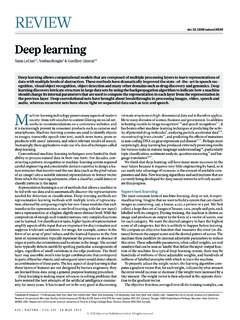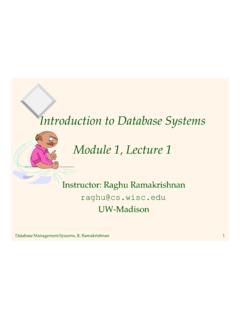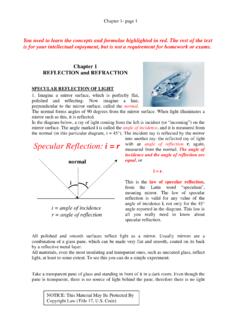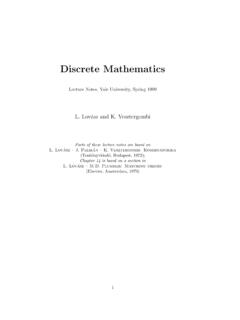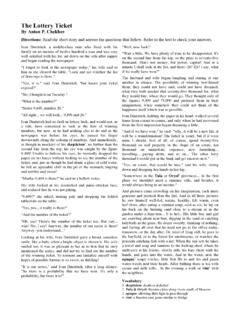Transcription of Scheduling: Proportional Share - University of Wisconsin ...
1 9 scheduling : Proportional ShareIn this chapter, we ll examine a different type of scheduler known as aproportional-sharescheduler, also sometimes referred to as afair-sharescheduler. Proportional - Share is based around a simple concept:insteadof optimizing for turnaround or response time, a scheduler might insteadtry to guarantee that each job obtain a certain percentage of excellent early example of Proportional - Share scheduling isfoundin research by Waldspurger and Weihl [WW94], and is known aslotteryscheduling; however, the idea is certainly older [KL88]. The basic ideais quite simple: every so often, hold a lottery to determine which processshould get to run next; processes that should run more often should begiven more chances to win the lottery.
2 Easy, no? Now, onto the details!But not before our crux:CRUX: HOWTOSHARETHECPU PROPORTIONALLYHow can we design a scheduler to Share the CPU in a proportionalmanner? What are the key mechanisms for doing so? How effective arethey? Basic Concept: Tickets Represent Your ShareUnderlying lottery scheduling is one very basic concept:tickets, whichare used to represent the Share of a resource that a process (or user orwhatever) should receive. The percent of tickets that a processhas repre-sents its Share of the system resource in s look at an example. Imagine two processes, A and B, and furtherthat A has 75 tickets while B has only 25. Thus, what we would likeis forA to receive 75% of the CPU and B the remaining 25%.Lottery scheduling achieves this probabilistically (but not determinis-tically) by holding a lottery every so often (say, every time slice).
3 Holdinga lottery is straightforward: the scheduler must know how many totaltickets there are (in our example, there are 100). The scheduler then picks12 scheduling : PROPORTIONALSHARETIP: USERANDOMNESSOne of the most beautiful aspects of lottery scheduling is its useofran-domness. When you have to make a decision, using such a randomizedapproach is often a robust and simple way of doing approaches have at least three advantages over more traditionaldecisions. First, random often avoids strange corner-case behaviors thata more traditional algorithm may have trouble handling. For example,consider the LRU replacement policy (studied in more detail in afuturechapter on virtual memory); while often a good replacement algorithm,LRU attains worst-case performance for some cyclic-sequentialwork-loads.
4 Random, on the other hand, has no such worst , random also is lightweight, requiring little state to track alter-natives. In a traditional fair- Share scheduling algorithm, tracking howmuch CPU each process has received requires per-process accounting,which must be updated after running each process. Doing so randomlynecessitates only the most minimal of per-process state ( , the numberof tickets each has).Finally, random can be quite fast. As long as generating a randomnum-ber is quick, making the decision is also, and thus random can be usedin a number of places where speed is required. Of course, the faster theneed, the more random tends towards winning ticket, which is a number from 0 to 991. Assuming A holdstickets 0 through 74 and B 75 through 99, the winning ticket simply de-termines whether A or B runs.
5 The scheduler then loads the stateof thatwinning process and runs is an example output of a lottery scheduler s winning tickets:63 85 70 39 76 17 29 41 36 39 10 99 68 83 63 62 43 0 49 12 Here is the resulting schedule:A A A A A A A A A A A A A A A AB B B BAs you can see from the example, the use of randomness in lotteryscheduling leads to a probabilistic correctness in meeting the desired pro-portion, but no guarantee. In our example above, B only gets to run 4outof 20 time slices (20%), instead of the desired 25% allocation. However,the longer these two jobs compete, the more likely they are to achieve thedesired Scientists always start counting at 0. It is so odd to non-computer-types thatfamous people have felt obliged to write about why we do it this way [D82].
6 OPERATINGSYSTEMS[ ] : PROPORTIONALSHARE3 TIP: USETICKETSTOREPRESENTSHARESOne of the most powerful (and basic) mechanisms in the design of lottery(and stride) scheduling is that of theticket. The ticket is used to representa process s Share of the CPU in these examples, but can be appliedmuchmore broadly. For example, in more recent work on virtual memory man-agement for hypervisors, Waldspurger shows how tickets can be used torepresent a guest operating system s Share of memory [W02]. Thus, if youare ever in need of a mechanism to represent a proportion of ownership,this concept just might be .. (wait for it) .. the Ticket MechanismsLottery scheduling also provides a number of mechanisms to manip-ulate tickets in different and sometimes useful ways.
7 One wayis withthe concept ofticket currency. Currency allows a user with a set of tick-ets to allocate tickets among their own jobs in whatever currencytheywould like; the system then automatically converts said currency into thecorrect global example, assume users A and B have each been given 100 A is running two jobs, A1 and A2, and gives them each 500 tickets(out of 1000 total) in A s currency. User B is running only 1 job and givesit 10 tickets (out of 10 total). The system converts A1 s and A2 s allocationfrom 500 each in A s currency to 50 each in the global currency; similarly,B1 s 10 tickets is converted to 100 tickets. The lottery is then held over theglobal ticket currency (200 total) to determine which job A -> 500 (A s currency) to A1 -> 50 (global currency)-> 500 (A s currency) to A2 -> 50 (global currency)User B -> 10 (B s currency) to B1 -> 100 (global currency)Another useful mechanism isticket transfer.
8 With transfers, a processcan temporarily hand off its tickets to another process. This ability isespecially useful in a client/server setting, where a client process sendsa message to a server asking it to do some work on the client s speed up the work, the client can pass the tickets to the server andthus try to maximize the performance of the server while the server ishandling the client s request. When finished, the server thentransfers thetickets back to the client and all is as ,ticket inflationcan sometimes be a useful technique. Withinflation, a process can temporarily raise or lower the number of ticketsit owns. Of course, in a competitive scenario with processes thatdo nottrust one another, this makes little sense; one greedy process could giveitself a vast number of tickets and take over the machine.
9 Rather, inflationcan be applied in an environment where a group of processes trust oneanother; in such a case, if any one process knows it needs more CPU time,it can boost its ticket value as a way to reflect that need to the system, allwithout communicating with any other 2008 20, ARPACI-DUSSEAUTHREEEASYPIECES4 scheduling : PROPORTIONALSHARE1// counter: used to track if we ve found the winner yet2int counter = 0;34// winner: use some call to a random number generator to5// get a value, between 0 and the total # of tickets6int winner = getrandom(0, totaltickets);78// current: use this to walk through the list of jobs9node_t*current = head;10while (current) {11counter = counter + current->tickets;12if (counter > winner)13break; // found the winner14current = current->next;15}16// current is the winner: schedule :Lottery scheduling Decision ImplementationProbably the most amazing thing about lottery scheduling is the sim-plicity of its implementation.
10 All you need is a good random numbergenerator to pick the winning ticket, a data structure to track the pro-cesses of the system ( , a list), and the total number of s assume we keep the processes in a list. Here is an example com-prised of three processes, A, B, and C, each with some number of :ATix:100 Job:BTix:50 Job:CTix:250 NULLTo make a scheduling decision, we first have to pick a random number(the winner) from the total number of tickets (400)2 Let s say we pick thenumber 300. Then, we simply traverse the list, with a simple counterused to help us find the winner (Figure ).The code walks the list of processes, adding each ticket value tocounteruntil the value exceedswinner. Once that is the case, the current list el-ement is the winner. With our example of the winning ticket being 300,the following takes place.

